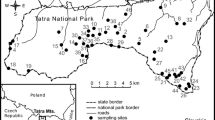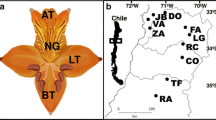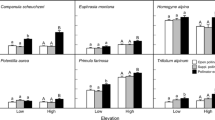Summary
The above-ground heights of inflorescences of 8 species of wild-flowers in a subalpine meadow in the Colorado Rocky Mountains were measured in two successive years. An index of overlap (of height-distributions) was computed for pairwise comparisons of all species. The species were assorted into 4 groups based on their usual pollinators: long-tongued bumblebees (3 species were pollinated by long-tongued bumblebees), short-tongued bumblebees (3 species), hummingbirds (1 species), and solitary bees (1 species). The values of the sample of overlap indices for plants pollinated by the same animals was significantly smaller than the values for plants pollinated by different animals; plants which share pollinators are less alike in height than those that don't share pollinators. It is suggested that this is a result of selection for enhancement of pollinator fidelity. The selective mechanisms, based on the ‘horizontal’ flight pattern of pollinators and the consequences to the plant of interspecific flights, are discussed.
Similar content being viewed by others
References
Bobisud, L.B., Neuhaus, R.J.: Pollinator constancy and survival of rare species. Oecologia. 21, 263–272 (1975)
Cody, M.L.: Competition and the structure of bird communities. Monogr. Pop. Biol., Vol. 7. Princeton, N.J.: Princeton Univ. Press. 1974
Faulkner, G.J.: Honeybee behaviour as affected by plant height and general colour in Brussels sprouts. J. Apic. Res. 15, 15–18 (1976)
Grant, V.: The flower constancy of bees. Bot. Rev. 16, 379–398 (1950)
Heinrich, B.: “Majoring” and “minoring” by foraging bumblebees, Bombus vagans: An experimental analysis. (Unpub. ms.)
Inouye, D.W.: Resource partitioning and community structure: a study of bumblebees in the Colorado Rocky Mountains. Ph.D. diss., Univ. of North Carolina (1976)
Levin, D.A., Anderson, W.W.: Competition for pollinators between simultaneously flowering species. Am. Nat. 104, 455–467 (1970)
Levin, D.A., Kerster, H.W.: Assortative pollination for stature in Lythrum salicaria. Evolution. 27, 144–152 (1973)
Proctor, M., Yeo, P.: The pollination of flowers. London: William Collins Sons and Co., Ltd. 1973
Pyke, G.H.: Local geographic distributions of bumblebees near Crested Butte, Colorado: competition and community structure (Unpub. ms.)
Rohlf, F.J., Sokal, R.R.: Statistical tables. San Francisco: W.H. Freeman and Company 1969
Savile, D.B.O.: Arctic adaptations in plants. Can. Dept. Agric. No. 6, 1–81 (1972)
Schoener, T.W.: The Anolis lizards of Bimini: resource partitioning in a complex fauna. Ecology, 49, 704–726 (1968)
Sokal, R.R., Rohlf, F.J.: Biometry. San Francisco: W.H. Freeman and Company 1969
Straw, M.: A Markov model for pollinator constancy and competition. Am. Nat. 106, 597–620 (1972)
Author information
Authors and Affiliations
Additional information
Contribution number 1669 from the Department of Entomology, University of Kansas, Lawrence, Kansas 66045
Rights and permissions
About this article
Cite this article
Waddington, K.D. Divergence in inflorescence height: An evolutionary response to pollinator fidelity. Oecologia 40, 43–50 (1979). https://doi.org/10.1007/BF00388809
Received:
Issue Date:
DOI: https://doi.org/10.1007/BF00388809




